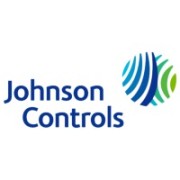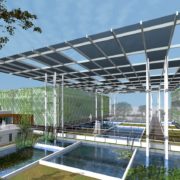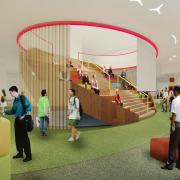ECOPHIT® CHILLED CEILING SYSTEM SAVES ENERGY WHILE MAINTAINING IDEAL THERMAL COMFORT
SINGAPORE- A recently conducted feasibility study in Singapore concluded that air conditioning energy consumption can be reduced by 26% using an ECOPHIT® chilled ceiling system instead of a conventional air-conditioning system. In the course of the study, the authors also noted that even higher total energy savings of 36% could be achieved when back-end systems are optimized.
The study into the energy use and overall effectiveness of Chilled Ceiling technology was carried out by the Energy Research Institute, Nanyang Technological University, Singapore. The study’s authors collaborated with the Germany-based SGL Group to install and operate ECOPHIT® chilled ceiling technology at ERI@N’s CleanTech One office space in Singapore.
The Energy Research Institute combined energy modelling simulations, with monitoring and analysis of the real parameters of the installations and verification (through sub-metering), to show how a chilled ceiling system – a form of radiant cooling – achieves significant energy savings when compared to a conventional air-based system, while maintaining ideal thermal comfort for the building’s occupants.
Due to the hot and humid weather conditions in Singapore, air conditioning is widely used in buildings. The high cooling demands, met by conventional air-conditioning technology, result in very high energy consumption of buildings. Radiant Cooling technology – and more specifically, a chilled ceiling system, presents a more energy efficient alternative.
A chilled ceiling system is a type of low energy-higher inlet water temperature cooling system that uses radiant cooling to cool a building space. A chilled ceiling is a ‘drop-down’ ceiling comprising of water-carrying pipes embedded in thin, conductive slabs and e.g. mounted on a metal ceiling plate. Using the ECOPHIT® technology, the conductive slabs are made from carbon delivering a very high level of thermal conductivity and control dynamics. This system cools the occupants in the room through radiation and natural convection using the chilled ceiling as a heat sink for the heat load in the building.
The chilled ceiling technology originated in Europe and is popular in temperate climates around the world. Key benefits of using chilled ceiling systems over conventional all-air systems include higher occupant comfort and lower equipment and material costs.
According to See Chenn Wang, Director Asia at SGL Singapore Pte Ltd, the air conditioning systems in most buildings in Singapore make up 50% of a building’s total electricity consumption. “One of the biggest challenges in achieving energy efficiency in buildings is to create a high indoor comfort level, while reducing the amount of energy consumed by air conditioning. Hence, there is a lot of interest to test innovative and more energy efficient air-conditioning systems that could replace current technology in Singapore and other tropical regions.”
Mohamed Alami, Managing Director at SGL Lindner adds: “ECOPHIT® delivers the right solution with innovative components made from recyclable natural graphite that make air conditioning in buildings more comfortable, efficient, and environmentally friendly. ECOPHIT® ensures more efficient air conditioning in every type of building, and has proven itself in a variety of large scale projects including office buildings, hotels, public buildings and airports.”
ECOPHIT® is an expanded natural graphite product and has been proven, in more temperate climates, to be highly suitable for radiant cooling. Using graphite-material allows for a rapid and more even cooling across the entire room. The authors at NTU selected this technology because of its high performance, high heat transfer rates and light weight.
ECOPHIT® offers a complete ecological and economical solution for energy efficient temperature control in buildings. A natural product made from graphite, ECOPHIT® offers outstanding design freedom, cost effectiveness and maximum climate control for sustainable and modern new build and renovation projects. The performance of this outstanding and energy-efficient technology can be observed in numerous buildings in Europe and all over the world.











